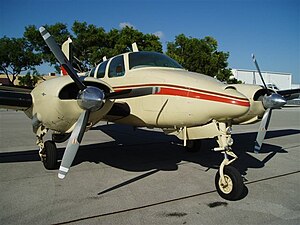Beechcraft Twin Bonanza
| Model 50 Twin Bonanza | |
|---|---|
 |
|
| Supercharged 1961 J50 Twin Bonanza | |
| Role | Utility aircraft |
| Manufacturer | Beech Aircraft Corporation |
| First flight | 15 November 1949 |
| Introduction | 1951 |
| Status | Active |
| Primary user | Private operators |
| Produced | 1951–1961 |
| Number built | 975 (includes 195 L-23) |
| Variants | L-23/U-8 Seminole |
| Developed into | Beechcraft Queen Air |
The Beechcraft Model 50 Twin Bonanza was a small twin-engined aircraft designed by Beechcraft as an executive transport for the business market. It was developed to fill a gap in Beechcraft's product line between the single-engined Model 35 Bonanza and the larger Model 18. The Twin Bonanza is about 50% larger than the Bonanza, has more powerful engines, and is significantly heavier, while in its earliest form having only half the passenger capacity of the Model 18.
The Twin Bonanza is not a true twin-engined derivative of the Bonanza since the cabin is wider and longer, however it did use some of the tooling jigs for the Bonanza as did the Travel Air (which was a closer derivative designed later).
The Twin Bonanza was first flown on 15 November 1949 after rapid development, begun only in April of that year. The Model 50's type certificate was awarded in 1951, and production began the same year. The United States Army adopted the Twin Bonanza as the L-23 Seminole utility transport, making it the largest fixed-wing aircraft in its inventory at that time. According to Ralph Harmon, the airplane's designer, during an initial demonstration flight for the Army, Claude Palmer, a Beechcraft Demonstration Test Pilot, crashed while trying to land over a 50-foot (15 m) tree line while full of soldiers and sandbags. Everyone on board walked away from the crash. The Army was impressed with the structural strength of the Twin Bonanza, eventually purchasing 216 of the 994 examples produced. It was also the first twin-engined aircraft in its class to be offered to the business market, but the Korean War was raging in the early 1950s and the US Army took almost the entire production for 1952 and 1953. The Beechcraft Model 65 Queen Air and Model 90 King Air are both direct descendents of the Model 50 Twin Bonanza. All three aircraft share the same basic wing design, as well as landing gear, flaps, instrument panels, fuel cells, and more. The Queen Air added a larger cabin to the design, while the later King Air added turbine power and pressurization. Twin Bonanza production ended in 1963 while the King Air was under development.
In January 2012 the Australian Civil Aviation Safety Authority issued an airworthiness directive grounding all Bonanzas, Twin Bonanzas and Debonairs equipped with a single pole-style yoke, having forward elevator control cables more than 15 years old, until they could be inspected. The AD was issued based on two aircraft found to have frayed cables, one of which suffered a cable failure just prior to takeoff and resulting concerns about the age of the cables in fleet aircraft of this age. At the time of the grounding some Bonanzas had reached 64 years in service. Aircraft with frayed cables were grounded until the cables were replaced and those that passed inspection were required to have their cables replaced within 60 days regardless. The AD affected only Australian aircraft and was not adopted by the airworthiness authority responsible for the type certificate, the US Federal Aviation Administration. The FAA instead opted to issue a Special Airworthiness Information Bulletin (SAIB) requesting that the elevator control cables be inspected during the annual inspection.
...
Wikipedia
